Way back in the beginning of this year, chefs identified zero-waste cooking and cannabidiol (CBD)-infused food and beverages as top trends for 2019. [1]
According to the chefs surveyed by the U.S. National Restaurant Association, "Infusing food and drink with cannabis and CBD could create unique cuisine opportunities and potential new markets for experiential dining occasions."
Well, they were right.
CBD-infused food and beverages are simply everywhere and in every conceivable preparation. The hipster niche is thoroughly captured with countless trendy must-haves, and fine dining just became dope. (Scrumptious dark chocolate salted caramel almonds with CBD, anyone?)
Contents
1. CBD Cooking is a THING and it's FUN!
2. Six Tips for Cooking with CBD You Shouldn't Work Without
2.1 Getting Ready
a) Tincture or Extract?
b) Which CBD Product to Use
c) How Much CBD to Use
2.2 Get Cooking
d) Hot or Not?
e) Water or Oil—which Mix is Best?
f) Recipes and Other Cooking Tips
3. Benefits of CBD-Infused Food
4. How Safe is CBD Cooking?
5. Conclusion
CBD Cooking Is a THING and It's FUN!
Making homemade CBD meals is often the most fun. So why wait—diffuse those difficult get-togethers by treating your guests to a CBD-infused dinner or CBD-infused drinks and desserts.
Everyone will leave wondering why they're so happy and content all of a sudden...
But before you drip CBD oil in that heated frying pan—hang on a bit. CBD cooking is not rocket science, but there are some things to keep in mind for the best results.
We compiled a list of tips to help you make the most of your CBD-infused meals.
The method is simple (you basically just add CBD to any food or drink you prefer), but for the tastiest results, stick to these few guidelines.

Six Tips for Cooking with CBD You Shouldn't Work Without
1. GETTING READY
a) Tincture or Extract?
You decided to cook with CBD, and now you're wondering whether you should go buy a tincture or an extract. First of all—know the difference, and then check the labels.
Tinctures are a subset of extracts.
Herbal extracts are usually dissolved in a non-alcoholic solvent. These can include vinegar, glycerine, water, and so forth. They are traditionally made from dry plant material and tend to contain plant fibers. Extracts can be much more potent than tinctures. So, your dose will be smaller.
A tincture is a concentrated herbal extract that is usually dissolved in an ethanol/alcohol solvent. It's traditionally made from fresh-off-the-land plant material, a process that starts within hours of harvest. The plant-versus-solvent ratio can range from 1:3 to 1:8, which will determine how much you will add to your CBD foods.
So, what should guide you in this regard is the strength of the CBD you want to add to your dishes.
A tincture will more likely contain the full spectrum of healthful compounds found in hemp, while an extract could be more potent.

b) Which CBD Product to Use
We're moving farther and farther away from the time of illegal CBD, but regulatory processes are still...well, in the developmental stage.
This means that there's no standardization of product quality and content just yet. This leaves it to the consumer (read: you) to put on their discerning glasses when shopping for CBD.
Don't fall victim to snake-oil vendors! Keep these checkpoints close while shopping.
RELATED: How to Choose a High-Quality CBD Oil
Look out for the following on the labels:
(i) Buy Organic: This one's a no-brainer. Organically derived CBD is largely free from contaminants (that can be pretty harmful) and have been cultivated according to strict guidelines.
Look out for the U.S. Department of Agriculture (USDA)'s "Certified Organic" seal.
The USDA explains that fulfilling the following requirements will earn products this coveted seal:
- Produced without excluded methods, (e.g., genetic engineering, ionizing radiation, or sewage sludge).
- Produced using allowed substances.
- Overseen by a USDA National Organic Program-authorized certifying agent, following all USDA organic regulations.
They also mention:
People who sell or label a product "organic" when they know it does not meet USDA standards can be fined up to $17,952 for each violation.
So, you can be reasonably sure that you're holding a good product if the USDA seal appears on the label.
(ii) Buy CO2 Extracted: This extraction method uses no heat, which means that it leaves most of the plant nutrients intact.
This should matter to you because of the so-called entourage effect associated with cannabis. This effect very basically refers to cannabinoids (such as CBD) and other compounds working better together than as isolates.
The CO2 extraction method is also more environmentally friendly.
RELATED: What Does "Full Spectrum CBD" Mean?
(iii) Buy Whole-Plant CBD: As said, CBD works better with other cannabis compounds like tetrahydrocannabinol (THC), terpenes, and other phytonutrients found in the plant.
This will be indicated on the label as "full spectrum" or "full plant" CBD.
Broad-spectrum CBD will contain most of the other compounds, but not THC. This is the cannabinoid responsible for the characteristic "high" marijuana is known for. It works well with CBD, and only a trace amount is needed.
But if you're wary of side effects (unlikely, if THC content is low) or legal repercussions (0.3% THC is legally permissible), look out for a CBD isolate. Not ineffective, but more difficult to determine the ideal dose with.

RELATED: Understanding the Entourage Effect of Cannabinoids
(iv) Buy Mgs of CBD: Don't buy products with only the CBD oil percentage displayed on the label. Look for CBD mg per dose and/or per bottle. A high quantity of low-quality CBD will be less effective than a lower quantity of high-quality CBD.
In other words—a ten percent CO2-extracted CBD oil of high quality will be better than fifty percent butane-extracted CBD oil of substandard quality.
(v) Buy from Transparent Merchandisers: No, no need to contact Hogwarts for help to seek out invisible vendors.
You want transparency and a sense of good business ethics when you look at the seller's product labeling (no outrageous, illegal health claims) and their marketing material (more informative than sales-oriented, with clear and working contact details on the labels and their website).
If you want more information, contact the seller. If your email doesn't bounce and they reply quickly with sound answers—dem's your vendor.

(vi) Buy CBD Oil That's Been Lab Tested: Make sure the company has had their products lab tested and that the results are readily available to the public. This will show clearly what's in the oil you use.
c) How much CBD to Use
As mentioned, this will depend on the type of CBD you use. Check what the label says and follow Xwerk's advice:
Cooking with CBD oil is an art. If you use too much, it can become overpowering and costly. Too little, and you won’t get to enjoy the healthful effects. Plus, if you make something and don’t like it, it’s a shame to waste any CBD oil.
Also, a little CBD oil goes a long way, both flavor- and health-wise. Start with a small amount of CBD and work up, particularly if your CBD oil is highly concentrated. The higher the mg/drop, the less you’ll need to add.
Everyone responds differently to CBD oil. A renowned cannabis chef, Gabe Kennedy, suggests starting out with 10 mg of full-spectrum oil.
Talking to MIC in an interview, he explained that if you feel fine after the CBD meal, you could add a slightly higher dose next time. [3]
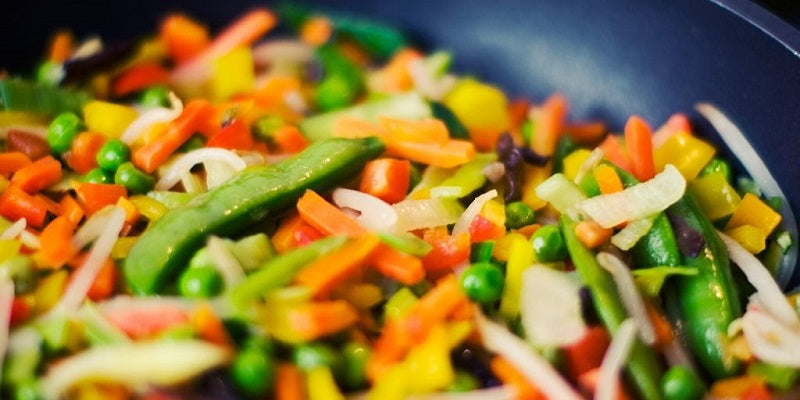
2. GET COOKING
Now let's get busy in the kitchen...
d) Hot or Not?
Cooking temperature is an important point.
Kennedy and Henry Lu, also a chef consulted by MIC, advises not to cook CBD oil over direct heat. Don't even sauté with it, Kennedy says, and definitely don't deep fry with it.
Lu agrees and also recommends not heating it above 120 degrees Fahrenheit. “It’s not a very good cooking oil. It gets really bitter.”
Overheating the oil could also cause the CBD to lose its potential efficacy.
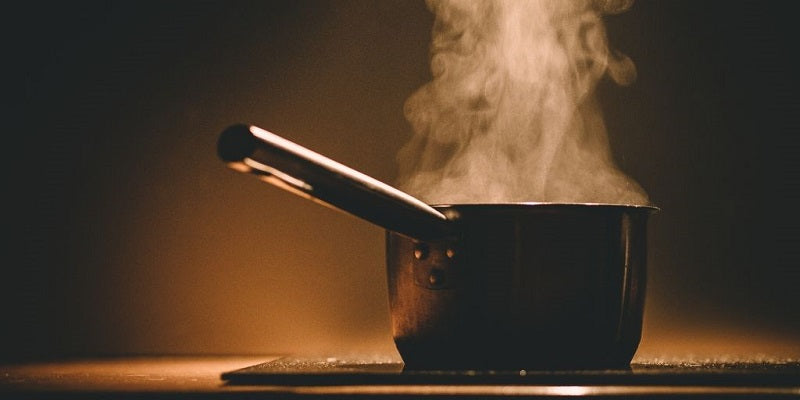
e) Water or Oil—Which Mix is Best?
Definitely oil. CBD is lipophilic, which means that its molecules bind with oil molecules in the body. So an oil base will ensure proper and maximum absorption, which is what you want.
f) Recipes and Other Cooking Tips
Most recipes with CBD tend to be for sweets and/or baked goodies. This is because sweetness easily masks CBD's rather bitter taste. Chocolate is great at masking bitterness, too.
Always stir the ingredients very well during mixing—probably more than you usually do. This is to ensure that the CBD is evenly distributed throughout the dish.
But let's turn to the chefs again.
Lu advises that if you’re worried about CBD oil overpowering an entire dish with its robust flavor, create balance by spreading it out over multiple parts of a dish.
He likes to incorporate it into an aioli. Aioli is a mayonnaise-type emulsified sauce with a thousand uses.
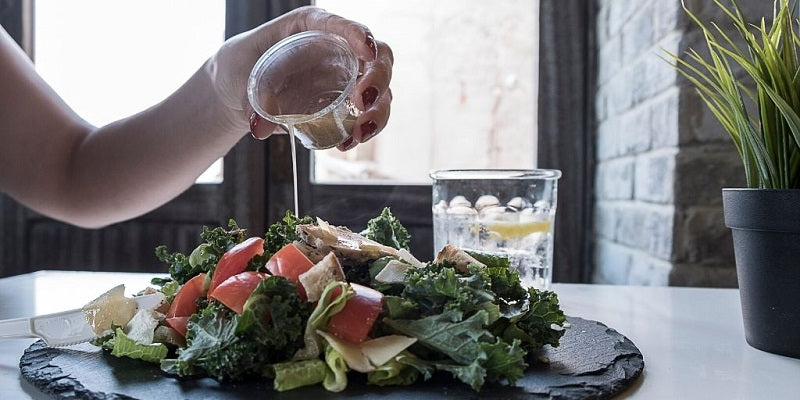
RELATED: Best CBD Vegan Chocolate Recipes
Lu also dresses salads with it and uses it as a finishing oil.
Buy a ready-made CBD olive oil, or consider making your own. Buy a high-quality olive oil and add a few drops of high-quality CBD oil. Experiment with strength.
The store-bought CBD-laced cooking and salad oils are, as a rule, not very potent, but at least they're easily accessible.
Lu shared this beautiful (and super easy!) pesto recipe to whip up and serve on roasted veggies.

Kennedy kindly divulged a nourishing CBD smoothie recipe. It’s to die for, it's so tasty.
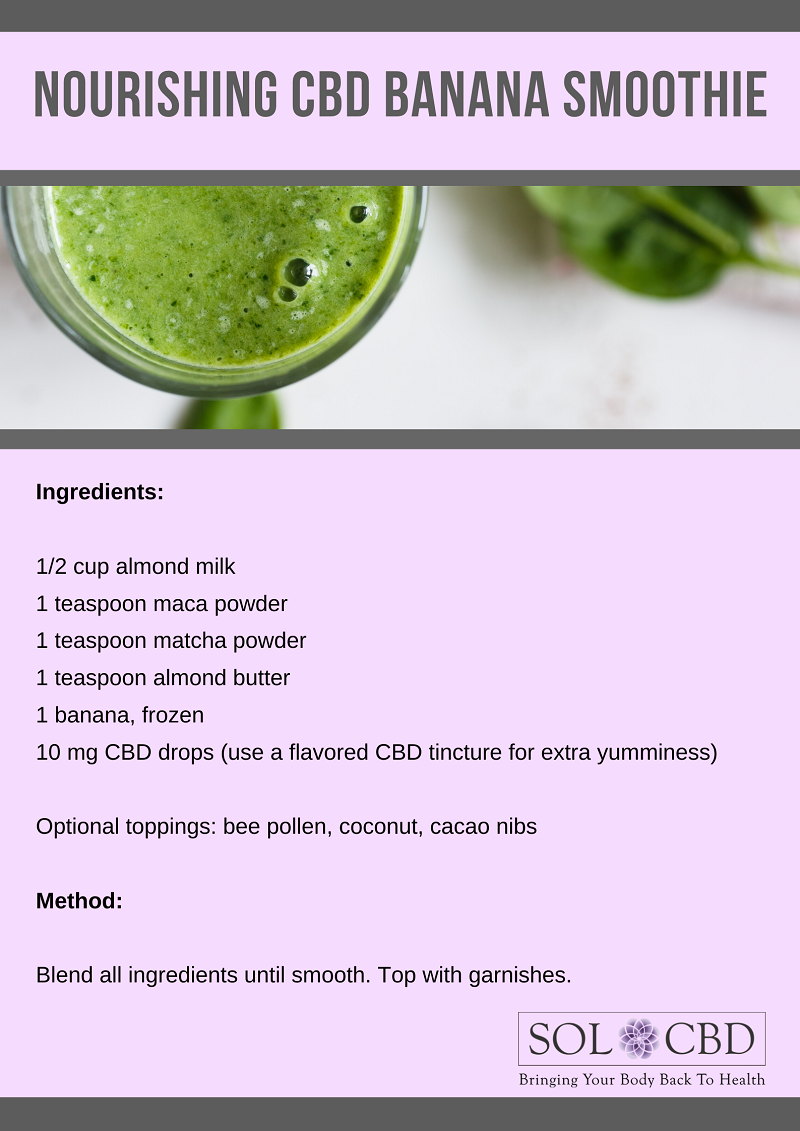
Benefits of CBD-Infused Food
The benefits of this cannabinoid are no secret—any web search should quickly convince you of that.
Taking it as part of a dish has the benefit that the food's oil and fats may increase CBD absorption.
Also, many users report that the effect of the CBD seems to last longer when you ingest it with food. They all love it for many reasons.
Adding it to food can improve its palatability, especially for younger users and the elderly.
Here are some of the indications science loves it for. (Research is far from complete, and only a few products are registered medicinal CBD. Those can only be obtained with a prescription or as part of a governmental medical marijuana program.) [4]
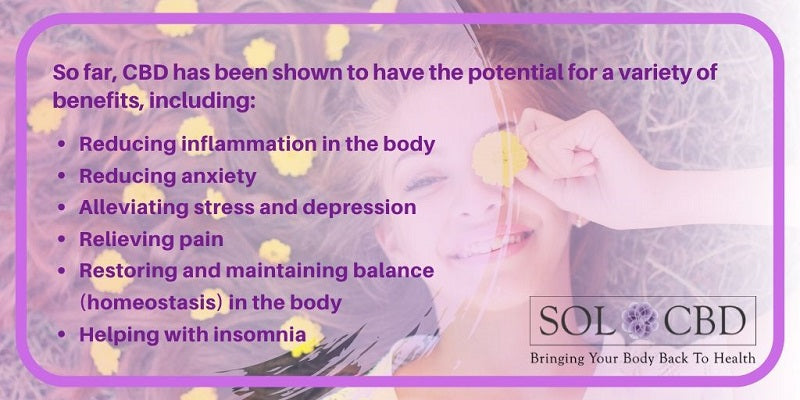
RELATED: Top 5 Ways to Reduce Chronic Joint Pain Naturally – Cannabidiol (CBD)
How Safe is CBD Cooking?
Hundreds of thousands of users rely on CBD for various reasons every day. The cannabinoid's popularity has skyrocketed since hemp was declared legal in the States last year—for all of the reasons mentioned and more.
It's also popular for its excellent safety profile. The most reported side effects include:
- dry mouth
- thirst
- fatigue
- diarrhea
- weight or appetite changes
CBD is not a regulated supplement, though, and it cannot be advertised as such.
Never replace or supplement prescription medicine with CBD without your doctor's consent.
Also note that CBD can interfere with some medicines' efficacy and safety. (Think the usual suspects, such as anticoagulants, most psychiatric medicines, hypertensives, etc.) Again, consult with a medical professional if you're on these or any other chronic medications before taking CBD.
For the most part, though, the cannabinoid is safe to experiment with.
It does not cause the "high" cannabis with high THC is known for. For the most part, it's only likely to increase a sense of well-being and relaxation. [5]
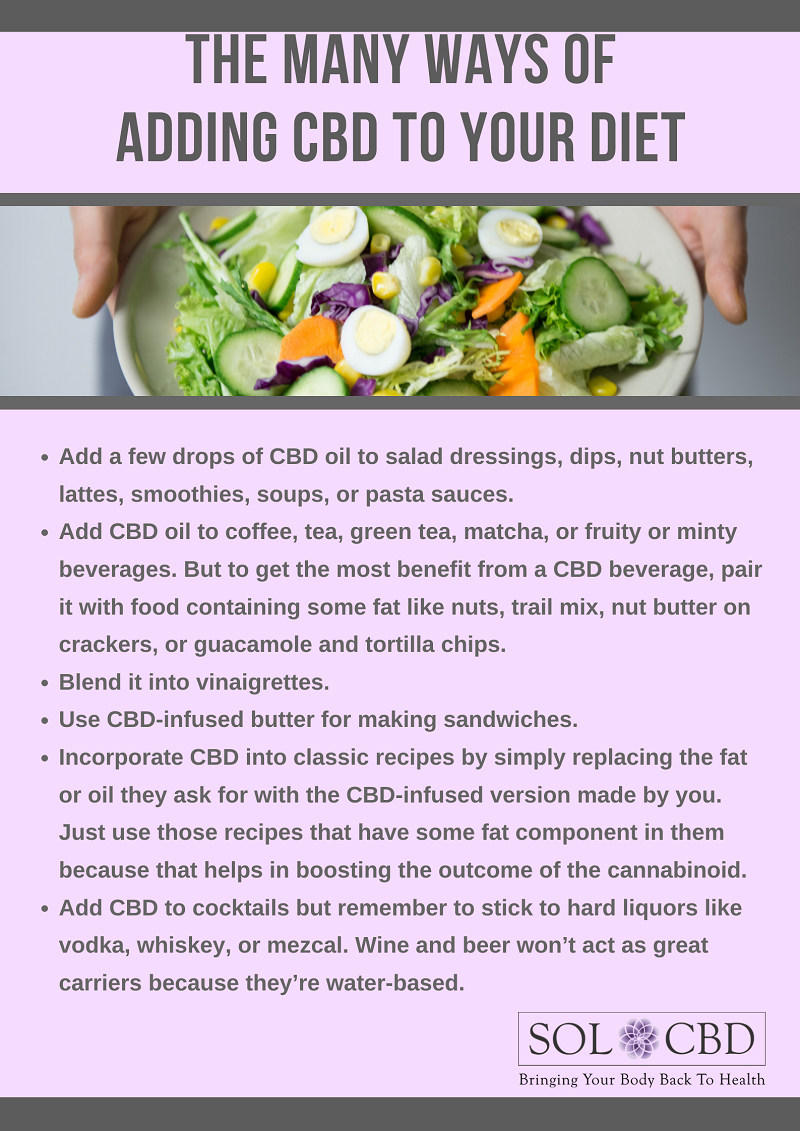
RELATED: 8 Proven CBD Oil Health Benefits You Should Know About
Conclusion
Take your cooking and your health to the next level by adding a dash of CBD. Allow your creativity to shine; experiment and remember to have fun!
Resources:
- https://restaurant.org/Articles/News/CBD-cannabis_infused-food-drink-whats-hot-2019
- https://xwerks.com/blogs/cbd/cooking-with-cbd
- https://www.mic.com/p/cooking-with-cbd-oil-is-only-worth-it-if-you-keep-these-4-rules-in-mind-18228725
- https://www.who.int/medicines/access/controlled-substances/5.2_CBD.pdf
- https://www.ingentaconnect.com/content/ben/cds/2011/00000006/00000004/art00005




























